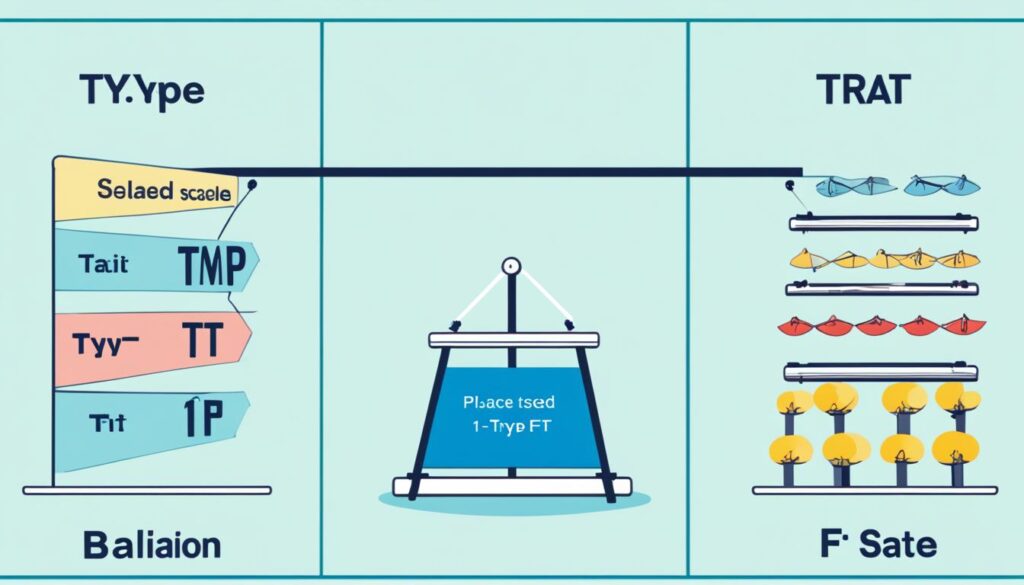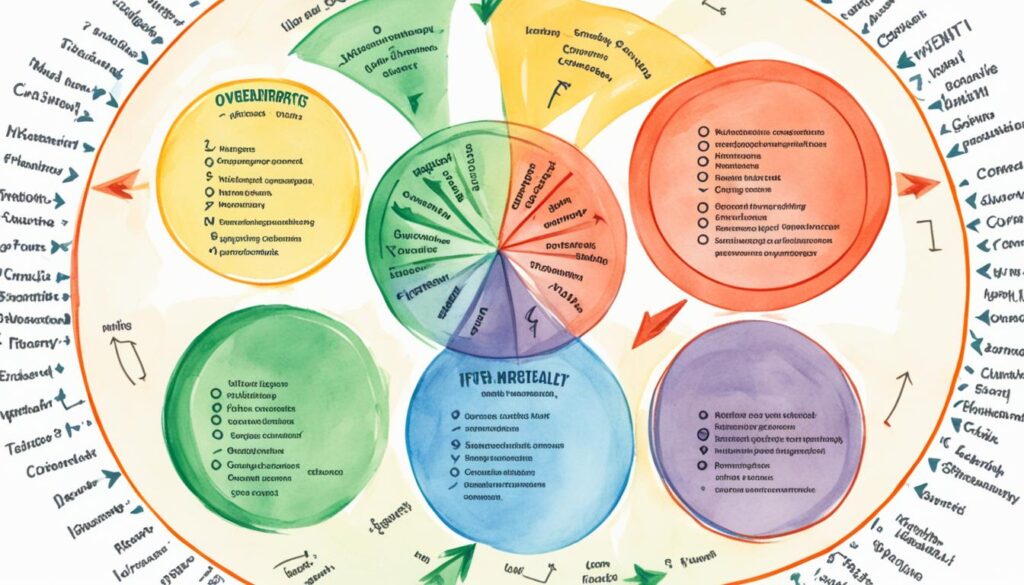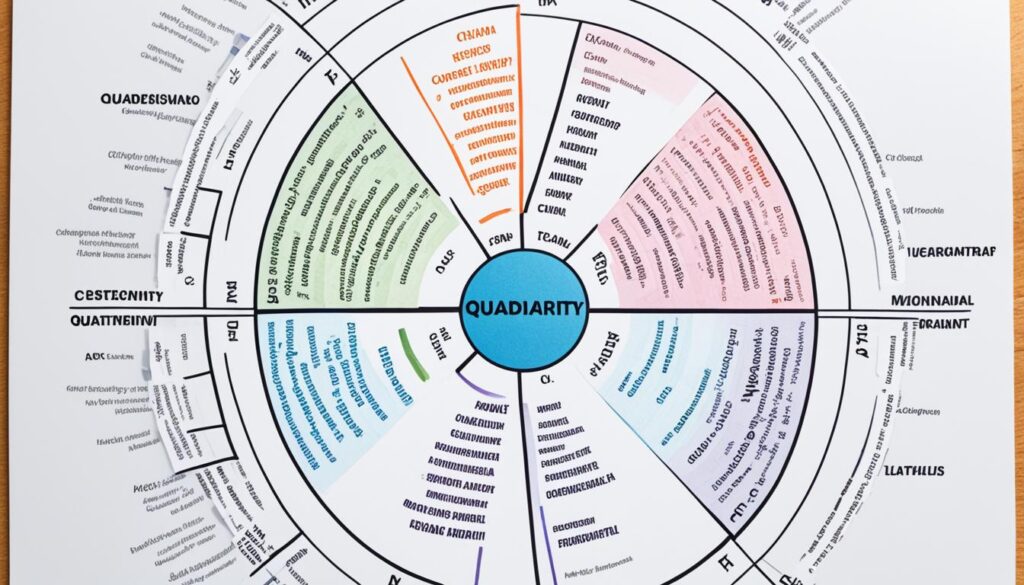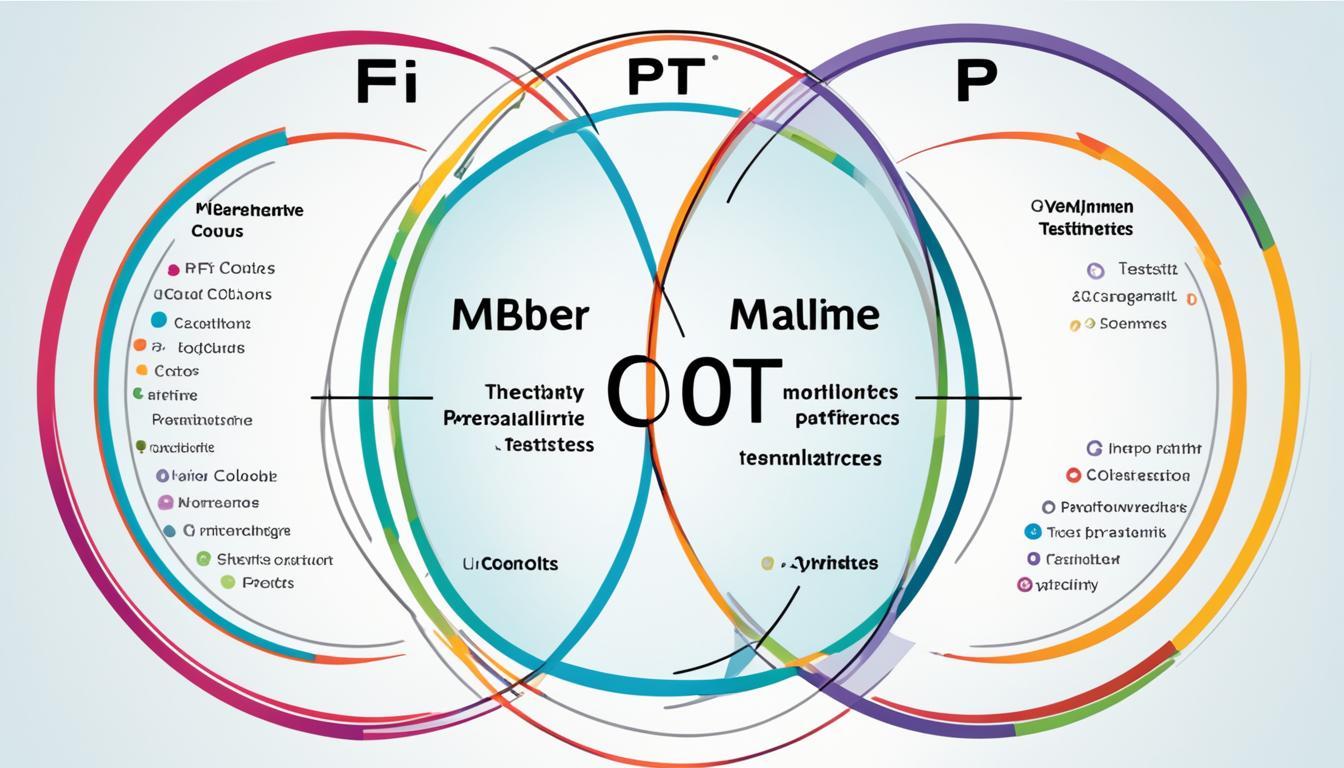Did you know that both the 16PF and MBTI, two well-known personality assessments, offer unique insights into the complexities of human behavior? While they share similarities, there are key distinctions that differentiate them. Understanding how these assessments intersect can result in a comprehensive understanding of an individual’s personality and behavioral tendencies.
Key Takeaways:
- The 16PF and MBTI offer unique approaches to understanding personality.
- The 16PF is a trait-based questionnaire, while the MBTI is a type-based questionnaire.
- Both assessments provide valuable insights into personal preferences and behavioral patterns.
- The combined application of 16PF and MBTI can offer a more in-depth understanding of an individual’s personality.
- Consider the specific context and purpose of assessment when choosing between the 16PF and MBTI.
Type-based vs Trait-based Questionnaires
When it comes to understanding personality, there are different approaches, and this is where the distinction between type-based and trait-based questionnaires comes into play.
Type-based questionnaires, like the MBTI (Myers-Briggs Type Indicator), help individuals determine which distinct type best fits them. The MBTI assesses preferences across four dimensions: extraversion/introversion, sensing/intuition, thinking/feeling, and judging/perceiving. Based on these preferences, the MBTI offers 16 different types, each representing a unique combination of these dimensions. For example, a person might be classified as an introverted, intuitive, thinking, and perceiving (INTP) type.
Trait-based questionnaires, such as the 16PF (16 Personality Factors), take a different approach by measuring multiple personality traits or factors. Each trait is seen as a continuum, allowing for comparisons between individuals. The 16PF measures factors such as warmth, emotional stability, dominance, and openness to change, among others. Rather than categorizing individuals into distinct types, trait-based questionnaires provide a more nuanced understanding of an individual’s personality.
Both type-based and trait-based questionnaires have their own strengths and can offer valuable insights into personality. Type-based questionnaires like the MBTI provide a simplified framework for understanding individual differences, while trait-based questionnaires like the 16PF delve into the complexities of personality through the measurement of multiple factors.
Ultimately, the choice between type-based and trait-based questionnaires will depend on the specific needs and preferences of the individual or organization using them. Some find the simplicity of type-based questionnaires more accessible and relatable, while others appreciate the depth and detail provided by trait-based questionnaires.

| Type-Based Questionnaires (MBTI) | Trait-Based Questionnaires (16PF) |
|---|---|
| Classifies individuals into distinct types based on preferences for extraversion/introversion, sensing/intuition, thinking/feeling, and judging/perceiving. | Measures multiple personality traits or factors on a continuum. |
| Provides 16 different types, each representing a unique combination of preferences. | Measures factors such as warmth, emotional stability, dominance, and openness to change, among others. |
| Simplified framework for understanding individual differences. | Offers a more nuanced understanding of personality through the measurement of multiple factors. |
As shown in the table, the MBTI and 16PF differ in their approach to assessing personality. While the MBTI focuses on type classification, the 16PF measures a range of personality factors. Understanding the distinctions between these approaches can help individuals and organizations make informed choices when selecting the most appropriate questionnaire for their specific needs.
Benefits of MBTI and 16PF
The MBTI and 16PF assessments offer valuable insights into personal preferences and behavioral styles, providing individuals with a comprehensive understanding of their personalities. Both assessments serve distinct purposes and provide unique benefits.
| MBTI | 16PF |
|---|---|
| Offers an inside-out approach | Provides a more detailed and specific personality picture |
| Helps individuals understand their own preferences and the differences between people | Delves into an individual’s feelings and emotions |
| Provides straightforward insights into an individual’s personality and how they perceive the world | Measures various factors to give a comprehensive understanding of behavioral style |
“The MBTI offers an inside-out approach, helping individuals understand their own preferences and the differences between people. It provides straightforward insights into an individual’s personality and how they perceive the world.”
By using the MBTI assessment, individuals can gain valuable insights into their preferences, such as whether they lean more towards extraversion or introversion and whether they rely on sensing or intuition. These preferences provide a foundation for understanding personal strengths, communication styles, and decision-making approaches. The MBTI assessment helps individuals embrace their unique characteristics and better navigate social interactions.

“The 16PF offers a more detailed and specific picture of an individual’s personality by measuring various factors. It delves into an individual’s feelings and emotions, giving a comprehensive understanding of their behavioral style.”
The 16PF assessment provides in-depth insights into an individual’s thoughts, emotions, and behaviors by measuring various personality factors. It uncovers aspects such as emotional stability, self-esteem, and social adaptability, allowing for a comprehensive understanding of one’s behavioral style. The 16PF assessment provides a rich and detailed portrayal of an individual’s personality, enabling personal growth and development.
Both the MBTI and 16PF assessments offer unique benefits and insights into personal preferences and behavioral styles. While the MBTI provides a broader understanding of personality dimensions, the 16PF offers a more specific and detailed picture. Together, these assessments contribute to a holistic understanding of an individual’s personality, empowering personal development, relationships, and career choices.
Combined Application of 16PF and MBTI
When it comes to gaining a comprehensive understanding of an individual’s personality, the combined application of the 16PF and MBTI assessments can provide real insights. By interpreting and feeding back the results together, we can unlock valuable information that deepens our understanding of behavioral styles.
One powerful aspect of this combined approach is the ability to explore how an individual’s MBTI preferences relate to specific 16PF scales. This allows for a more in-depth discussion and analysis of their personality traits and characteristics. By examining potential conflicts between the results, we can gain a clearer picture of how individuals navigate and adapt their preferences to align with societal expectations.
The combined application of the 16PF and MBTI assessments serves as a powerful development tool for individuals. It provides them with valuable insights into their own behavior, preferences, and strengths, which can then be leveraged for personal growth and achieving goals. Whether used in individual development or coaching programs, this combined approach offers a wealth of real insight that can drive positive change and foster personal transformation.
Through the integrated use of these two assessments, individuals can gain a deeper understanding of themselves, their interpersonal skills, and their potential for growth. By harnessing the unique insights provided by the 16PF and MBTI, we can unlock the true power of personal development and create pathways for success.
Key Benefits of the Combined Application:
- Gain a comprehensive understanding of an individual’s personality
- Interpret and feed back results for real insights
- Explore the relationship between MBTI preferences and 16PF scales
- Uncover potential conflicts and adjustments individuals make
- Use as a powerful tool for individual development and coaching programs

| 16PF | MBTI | Combined Application |
|---|---|---|
| Measures multiple personality traits or factors | Identifies distinct type based on preferences | Provides comprehensive understanding of personality |
| Delves into feelings and emotions | Offers insights into personal preferences | Unlocks behavioral style and personal growth opportunities |
| Allows for comparisons between individuals | Offers an inside-out approach to self-discovery | Drives positive change and transformation |
Practical Considerations for Using 16PF and MBTI
When incorporating the 16PF and MBTI in various scenarios, it is essential to understand their specific purposes and consider some practical considerations. The 16PF was primarily designed for selection purposes, making it a suitable tool for assessing candidate suitability for specific roles. On the other hand, the MBTI focuses more on understanding individual preferences and behaviors, offering insights into how people perceive and interact with the world.
After administering the questionnaires and collecting the results, it is crucial to facilitate a feedback session. This session provides an opportunity for individuals to discuss and agree on the interpretation of their results, gaining a deeper understanding of their own personality traits. The feedback session also serves as a platform for clarifying any questions or concerns that may arise.
Integrating the results of the 16PF and MBTI assessments can be a powerful tool for self-awareness and personal development. By combining the information from both tests, individuals gain a more comprehensive understanding of their behavioral style, preferences, and potential areas for growth. This integration provides a holistic view of their personality and unlocks valuable insights that can guide their personal and professional development goals.
Ultimately, the practical considerations for using the 16PF and MBTI involve harnessing the strengths of each assessment, leveraging their unique features, and tailoring their application to specific contexts. By understanding their purposes, conducting feedback sessions, and integrating the results, we can maximize the benefits derived from these assessments and empower individuals to gain deeper self-insight.

Relationship Between 16PF and MBTI Profiles
Research conducted by OPP® reveals intriguing correlations between 16PF and MBTI profiles, shedding light on the connection between these two personality assessments. By examining the scales and preferences of individuals, consistent patterns emerge, demonstrating the relationship between the 16PF factors and MBTI preferences.
Extraverted types, for example, tend to exhibit social boldness, liveliness, and dominance, aligning with their preference for engaging with others and their surroundings. Conversely, introverted types are often more private and self-reliant, emphasizing their inclination towards introspection and introspective tendencies.
When analyzing the sensing and intuition preferences, it becomes apparent that sensing types showcase a tendency towards perfectionism. In contrast, intuitives lean towards being more open to change and abstract thinking, emphasizing their exploratory and visionary nature.
Feeling types are frequently more sensitive and apprehensive, valuing empathy and emotional connections in their interactions. Conversely, thinking types tend to exhibit less sensitivity and prioritize logical reasoning and objective decision-making.
Judging types lean towards perfectionism and rule-consciousness, valuing structure, planning, and organization. On the other hand, perceiving types prefer a more flexible and adaptable approach, focusing on abstract thinking and embracing spontaneity.
Correlations Between 16PF and MBTI Profiles:
- Extraverted types: social boldness, liveliness, dominance
- Introverted types: privacy, self-reliance
- Sensing types: perfectionism
- Intuitive types: openness to change, abstract thinking
- Feeling types: sensitivity, apprehensiveness
- Thinking types: less sensitivity, logical reasoning
- Judging types: perfectionism, rule-consciousness
- Perceiving types: abstract thinking, flexibility
These correlations provide valuable insights into the relationships between the 16PF factors and MBTI preferences, enabling a deeper understanding of an individual’s personality and behavioral tendencies.

Uses of 16PF and MBTI in Recruitment and Personal Development
When it comes to recruitment processes, the 16PF and MBTI assessments play a crucial role in assessing a candidate’s suitability for a role. These tests provide valuable insights into an individual’s personality, allowing employers to make well-informed decisions about employee fit within their organization. By understanding a candidate’s personality traits, recruiters can determine how well they align with the company’s values, culture, and job requirements.
Moreover, the 16PF and MBTI are also widely used for personal development purposes. These assessments provide individuals with a deeper understanding of themselves and their areas for improvement. By uncovering their personality preferences, strengths, and weaknesses, individuals can embark on a journey of self-discovery and personal growth.
| Uses of 16PF and MBTI | Benefits |
|---|---|
| Recruitment | Assesses candidate suitability Determines employee fit within an organization |
| Personal Development | Enhances self-awareness Identifies areas for improvement Facilitates personal growth |
Recruitment: Assessing Candidate Suitability
During the recruitment process, organizations use the 16PF and MBTI assessments to evaluate candidates based on their personalities. By understanding a candidate’s personality traits, recruiters can gauge whether they possess the necessary qualities and behaviors for a specific role. For example, certain positions may require individuals who are extraverted, innovative, or detail-oriented, while others may call for introverted, analytical, or empathetic individuals.
By utilizing the insights from these assessments, recruiters can compare the candidate’s personality profile with the expected behavioral requirements and determine their potential success in the role. This approach ensures that organizations hire individuals who not only possess the required skills and qualifications but also align with the company’s values and work environment.
Personal Development: A Path of Self-Discovery
Personal development is a lifelong journey that involves gaining self-awareness, exploring strengths and weaknesses, and striving for continuous improvement. The 16PF and MBTI assessments contribute significantly to this journey by providing individuals with a comprehensive understanding of their personality traits and preferences.
By undergoing these assessments, individuals can identify their unique strengths and leverage them to achieve personal and professional success. They can also pinpoint areas for improvement and work towards enhancing their skills or overcoming limitations. This self-awareness fosters personal growth and enables individuals to navigate their careers more effectively.

Furthermore, the 16PF and MBTI help individuals understand how they interact with others and adapt to different situations. This knowledge can improve interpersonal relationships, communication skills, and collaboration within teams. Employers and managers also benefit from these assessments as they gain a better understanding of their employees, enabling them to tailor management approaches and create a more harmonious and productive work environment.
The combination of the 16PF and MBTI assessments in recruitment and personal development ensures that organizations make informed decisions about employee fit and that individuals embark on a journey of self-discovery and growth.
Reliability and Validity of 16PF and MBTI
The reliability and validity of the 16PF and MBTI have been the subject of ongoing debate. Critics argue that these tests lack predictive ability and yield inconsistent results.
Some detractors question the scientific foundation of these frameworks, suggesting that they are based on observations rather than empirical evidence. These criticisms raise concerns about the pseudo-scientific nature of these personality assessments.
When using the 16PF and MBTI, it is important to consider these limitations and criticisms. Interpret the results with caution, recognizing that they may not always provide a reliable and valid representation of an individual’s personality traits.
Introduction to the DISC Test for Personality Assessment
The DISC test offers an alternative approach to understanding personality, different from the well-known 16PF and MBTI assessments. This test categorizes individuals into four distinct personality types based on their dominance, influence, steadiness, and compliance. By exploring these four quadrants, the DISC test provides valuable insights into how individuals respond to various situations and their preferred interaction styles.
Unlike the 16PF and MBTI, which focus on broader personality traits, the DISC test delves into specific dimensions related to time, tasks, and other situational factors. This allows for a more targeted understanding of an individual’s behavior in different contexts. By identifying dominant, influential, steady, and compliant traits, the DISC test provides a comprehensive analysis of an individual’s personality.
The four quadrants of the DISC test are as follows:
- Dominance (D): Individuals with dominant traits take charge, make decisions quickly, and assert themselves in various situations. They are typically confident and assertive in their communication and approach to tasks.
- Influence (I): People with influential traits are outgoing, sociable, and persuasive. They enjoy building relationships, collaborating with others, and thrive in social settings. They are typically enthusiastic and optimistic.
- Steadiness (S): Individuals with steady traits are cooperative, reliable, and supportive. They value harmony, stability, and prefer working in a structured environment. They are typically patient, loyal, and dependable team players.
- Compliance (C): People with compliant traits are detail-oriented, analytical, and systematic. They excel in tasks that require precision, accuracy, and compliance with rules and procedures. They are typically cautious and value accuracy.
The DISC test provides a valuable tool for understanding an individual’s personality from a different perspective. By focusing on these specific dimensions, it offers unique insights into how individuals behave, communicate, and interact with others in different situations. This knowledge can be applied in various contexts, such as team building, leadership development, and improving interpersonal relationships.
Example of a DISC Test Profile
Here is an example of how a DISC test profile might look:
| Personality Type | Dominance (D) | Influence (I) | Steadiness (S) | Compliance (C) |
|---|---|---|---|---|
| Sample Profile | 65% | 75% | 45% | 55% |
In this example, the individual demonstrates high scores in dominance and influence, indicating a confident and sociable nature. Their steadiness score is moderate, suggesting a preference for stability but also adaptability. Finally, their compliance score reflects a moderate level of attention to detail and adherence to rules and procedures.

By utilizing the DISC test, individuals and organizations gain valuable insights into the intricacies of human behavior and interaction. Understanding the dominant, influential, steady, and compliant traits can help individuals navigate relationships, make informed career choices, and improve communication and collaboration within teams. The DISC test is a powerful tool to unlock the potential of individuals and promote personal growth and success.
Reliability of the DISC Test
The DISC test, similar to the 16PF and MBTI, has its own set of limitations that need to be considered. While it provides valuable insights into an individual’s interaction with their environment, it does not measure intelligence, morality, ambition, self-esteem, or motivation. It focuses specifically on the four dimensions of dominance, influence, steadiness, and compliance. Therefore, it is important to supplement the DISC test with other assessments to gain a comprehensive understanding of an individual’s personality.
While the DISC test has demonstrated reliability within its designated scope, it is crucial to acknowledge its limitations when interpreting the results. Each individual’s specific situational responses may vary and may not encapsulate the entirety of their personality. As with any assessment, it is essential to consider the context in which the DISC test is being used and to incorporate multiple sources of information for a more holistic understanding.
When utilizing the DISC test, it is beneficial to consider the specific objectives and desired outcomes. The test can provide valuable insights into an individual’s preferred behavioral style and how they respond in certain situations. However, it is important to take a broader view and consider other aspects of an individual’s personality and individual differences to paint a complete picture.
Conclusion
In conclusion, the 16PF and MBTI offer distinct approaches to understanding personality. The 16PF is a trait-based questionnaire that measures multiple personality factors, providing a detailed and specific picture of an individual’s behavioral style. On the other hand, the MBTI is a type-based questionnaire that categorizes individuals into 16 different types based on preferences for different dimensions.
When used together, the combination of 16PF and MBTI assessments can provide a powerful tool for personal development, team building, and recruitment. By interpreting and feeding back the results together, individuals can gain real insights into their personality, preferences, and behavioral patterns. The combined approach allows for a more comprehensive understanding of an individual’s behavioral style, which is useful in individual development, teambuilding, and career counseling.
While both the 16PF and MBTI have their critics and limitations, they can still provide valuable insights when used appropriately. It is important to consider the specific context and purpose of the assessment when choosing between the two. The 16PF is particularly suited for selection purposes, while the MBTI is more suitable for understanding preferences and behaviors.
FAQ
Is the 16PF the same as the MBTI?
No, the 16PF and MBTI are different personality tests that offer unique approaches to understanding human behavior.
What is the difference between type-based and trait-based questionnaires?
Type-based questionnaires, like the MBTI, determine an individual’s distinct type based on preferences for extraversion/introversion, sensing/intuition, thinking/feeling, and judging/perceiving. Trait-based questionnaires, such as the 16PF, measure multiple personality traits or factors on a continuum.
What are the benefits of using the MBTI and 16PF?
The MBTI provides straightforward insights into an individual’s personality and how they perceive the world, while the 16PF offers a more detailed and comprehensive understanding of an individual’s behavioral style by measuring various factors.
How can the 16PF and MBTI be combined in practice?
The combination of 16PF and MBTI assessments allows for a comprehensive understanding of an individual’s personality. By interpreting and feeding back the results together, real insights can be gained for individual development and coaching programs.
What practical considerations should be taken when using the 16PF and MBTI?
The 16PF is designed for selection purposes, while the MBTI is more suitable for understanding preferences and behaviors. It is crucial to provide a feedback session to discuss and agree on the results and to use the integration of 16PF and MBTI results for self-awareness and personal development.
What is the relationship between 16PF and MBTI profiles?
Research shows consistent correlations between 16PF factors and MBTI preferences, demonstrating patterns such as extraverted types exhibiting social boldness and dominance, while introverted types tend to be more private and self-reliant.
How are the 16PF and MBTI used in recruitment and personal development?
Both assessments are commonly used in recruitment to assess a candidate’s suitability for a role and in personal development to gain a better understanding of oneself and areas for improvement. They can also help create higher-performing teams and assist managers in managing employees effectively.
What is the reliability and validity of the 16PF and MBTI?
The reliability and validity of the 16PF and MBTI have been debated. Critics argue that these tests lack predictive ability and produce inconsistent results. It is important to interpret the results of these tests with caution.
What is the DISC test and how does it compare to the 16PF and MBTI?
The DISC test categorizes individuals into four personality types based on dominance, influence, steadiness, and compliance, focusing on specific dimensions related to interaction style. While the 16PF and MBTI examine broader personality traits, the DISC test provides insights into situational responses.
What are the limitations of the DISC test?
The DISC test does not measure intelligence, morality, ambition, self-esteem, or motivation. It should be used in conjunction with other assessments to gain a comprehensive understanding of an individual’s personality.
Eugene brings a fresh, dynamic voice to our platform as one of our talented Writers. Specializing in research-driven content, he explores the latest findings in psychology and personal growth, translating them into actionable insights for our readers. Eugene’s work is fueled by a curiosity about what makes us tick and a desire to help others unlock their potential.










